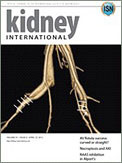Kramer AM, van Stralen KJ, Jager KJ, Schaefer F, Verrina E, Seeman T, Lewis MA, Boehm M, Simonetti GD, Novljan G, Groothoff JW. Kidney Int. 2011 Nov;80(10):1092–8. doi: 10.1038/ki.2011.232. Epub 2011 Aug 3. IF: 6.105

Department of Paediatrics
Abstract
Hypertension is a well-known complication in children on renal replacement therapy and an important risk factor for cardiovascular disease in later life. In order to define the prevalence of and risk factors for hypertension among children, we enrolled 3337 pediatric patients from 15 countries in the ESPN/ERA-EDTA Registry of whom 464 were on hemodialysis, 851 on peritoneal dialysis, and 2023 had received a renal allograft. Hypertensionwas defined as either systolic or diastolic blood pressures in the 95th percentile or greater for age, height, and gender or use of antihypertensive medication. Analyses were adjusted for age, gender, duration, and modality of renal replacement therapy. In 10 countries in which information on the use of antihypertensive medication was available, hypertension was present in over two-thirds of hemodialysis, peritoneal dialysis, or transplant patients. Blood pressure values above the 95th percentile were significantly more prevalent in very young patients (under 3 years) compared to 13- to 17-year olds (odds ratio 2.47), during the first year compared to over 5 years of renal replacement therapy (odds ratio 1.80), and in patients on hemodialysis compared to transplant recipients or those on peritoneal dialysis (odds ratios of 2.48 and 1.59, respectively). Over time, mean bloodpressures decreased in both hemodialysis and transplant patients, but not in peritoneal dialysis patients. Hence, our findings highlight the extent of the problem of hypertension in children with end-stage renal disease in Europe.
-mk-